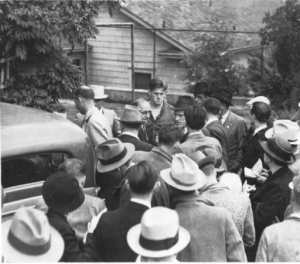The kidnapping and murder of Charles Lindbergh’s baby was international news for weeks and is still part of the nation’s psyche decades after the facts and theories of the case played out in real life.
Tacoma had its own set of famous kidnappings that were big news at the times they occurred. They have largely been forgotten to history, but they changed Tacoma in their own ways. One marked the turning point in pioneer history, one exemplified the crime, and one remains officially unsolved, but is often linked to an infamous serial killer.
The Kidnapping of John Boatman

The first of the landmark kidnappings illustrates the tensions between white settlers and Native Americans during the settlement boom of the mid-1800s. Willis Boatman and his wife Mary Ann had a small home on what is now 112th Street in Lakewood. The year was 1857, the Indian Wars were drawing to an end and the couple had just returned to their homestead. Mary Ann was in the kitchen and went to check on her two-year-old son, John, who had been playing in the yard. She couldn’t find him. He was missing.
Search parties formed.
Attention immediately focused on the Native Americans since their Chief Leschi had just been arrested. The rumor was that a group of Native Americans wanted to ransom him for the release of Leschi since he was facing the gallows.
The commander at nearby Fort Steilacoom, Lieutenant Colonel Silas Casey blasted that he would shoot any Native American believed to be involved in the kidnapping. The threat apparently worked. Searchers were gathering to plot out where else to work when they heard a single rifle shot. They ran to the sound of the noise and found young John, alive and unhurt. He had clearly not just wandered off since it was lightly raining and he was bone dry. The persistent rumor is that whoever nabbed him had wrapped him in a blanket to keep him warm and to also to muffle his screams since he was scared of blankets from that day forward.
The Kidnapping of George Weyerhaeuser

The roaring 20s and 30s were the peak of Tacoma’s upper crust, since it was a mill, trade and smelter town – all industries with titans of industry who made Tacoma their home.
The kidnapping of George Weyerhaeuser in May 24, 1935, marked the beginning of a rash of high-profile nabbings. The future president of the massive timber empire was just nine-years-old when he started walking the few blocks uphill from Lowell School to Annie Wright to have lunch with his sister. He was simply nabbed from the street. The local police immediately realized that this was not just a local crime and alerted the FBI.
The kidnappers wanted $200,000 cash. The bills were delivered as requested, and the boy was found safe in Issaquah after his captors set him free after almost two weeks of captivity. But even Weyerhaeuser’s release caused uproar. The farm owner immediately recognized him and called police. Rather than waiting for a police escort, he drove Weyerhaeuser home as news of his release leaked to some 50 reporters from around the nation who had arrived to cover the story. A less-than-compassionate reporter headed north to meet the car and even convince the farmer to let him drive the boy home. He got the scoop of his career during the interview on the way home.
Weyerhaeuser’s captors then slipped up by immediately starting to spend their ill-gotten money. The FBI had recorded their serial numbers. A handful of newspapers even published the entire list of bills, so once they started popping up in stores and banks, agents tracked the kidnappers’ shopping patterns and made their arrests.
The kidnappers were tried in Tacoma within the year and received 10 to 60 year sentences.
The Kidnapping of Charles Mattson
A similar kidnapping the following year didn’t end so well. Charles Mattson was 10-years-old when he disappeared on Christmas Eve of 1936. His parents were out looking at Christmas lights around the city when someone broke into the house and abducted the boy, leaving a note that demanded $28,000. The kidnappers never made contact after that, however. Mattson’s body was found three weeks later near Everett. The crime remains unsolved.
The Unsolved Disappearance of Ann Marie Burr

Another unsolved disappearance involves Ann Marie Burr. The eight-year-old girl wasn’t in her room when dawn came on August 31, 1961. Her parents found her room empty, and the front door was unlocked and open. She was never seen again.
It is long rumored that she was the first victim of serial killer Ted Bundy, who lived in the area. He lived about two miles away and his uncle lived in the Burr’s neighborhood. He was 14 and at least a casual member of the group of neighborhood kids that played together.
Bundy denied any involvement in her disappearance, but he did give a third-person recounting of a hypothetical abduction and murder of a girl during his childhood that included details similar to Burr’s disappearance.
Her case remains officially unsolved. But the legend that he buried Burrs in the foundation of a building on the University of Puget Sound campus remains fodder of speculation.







































